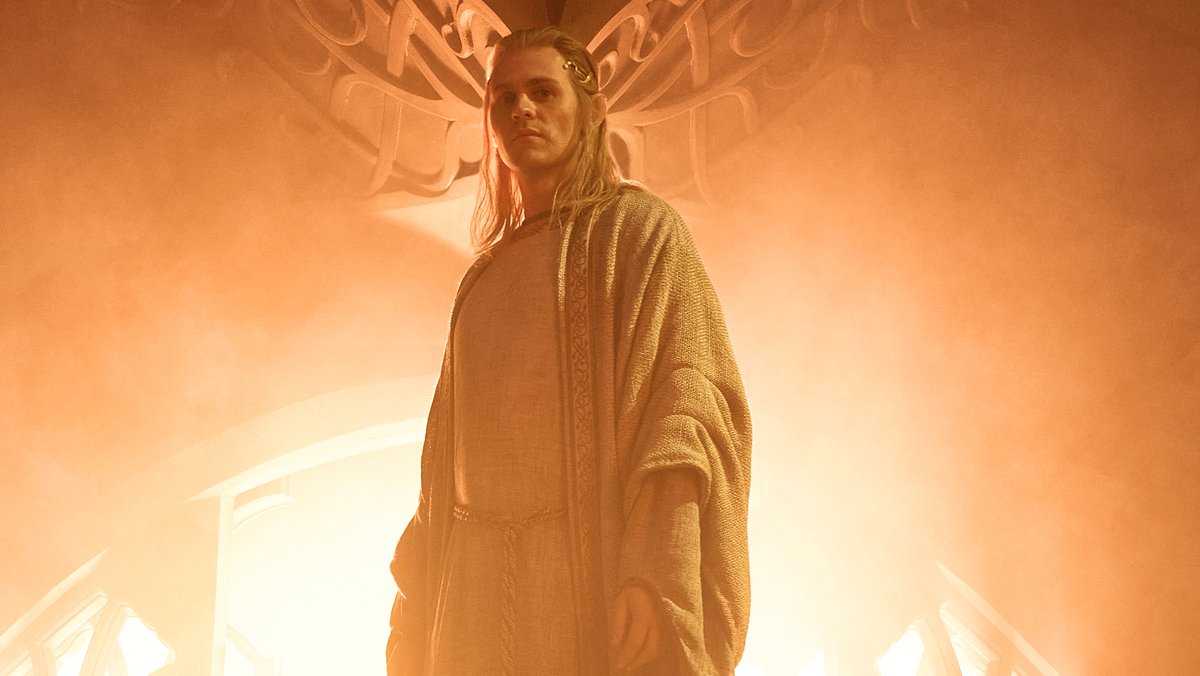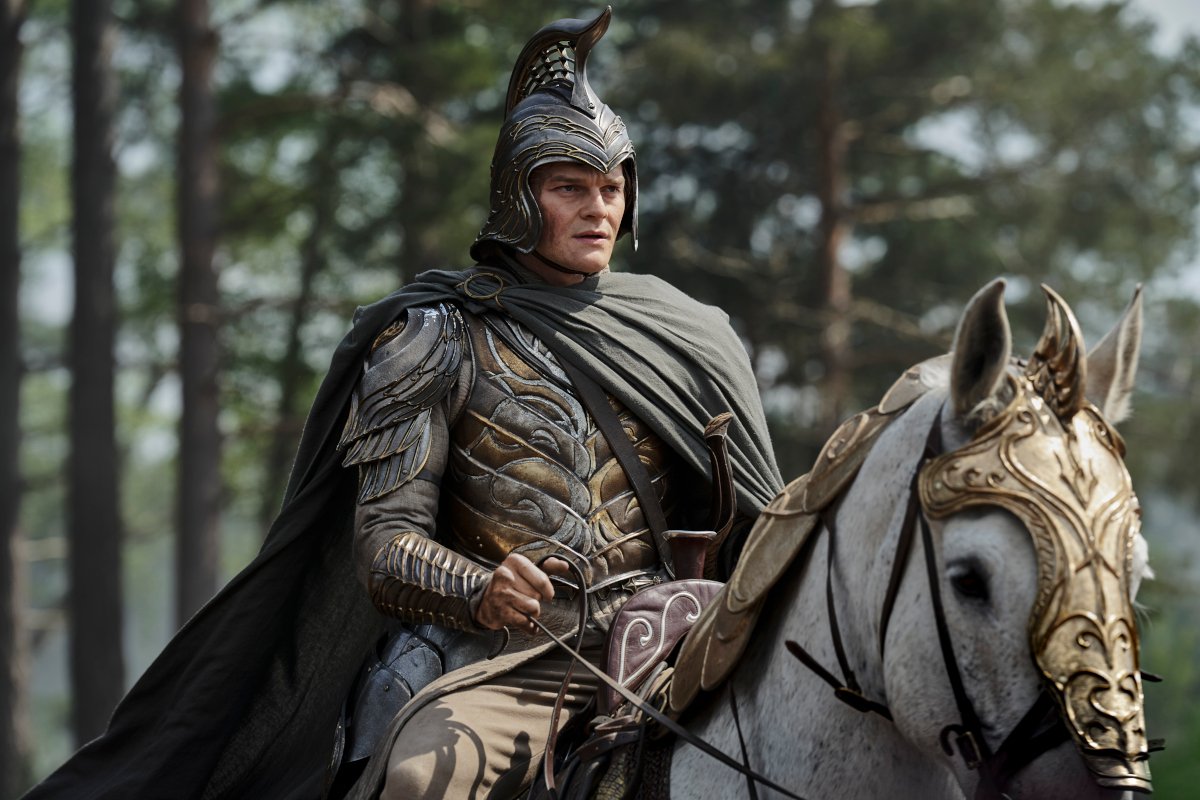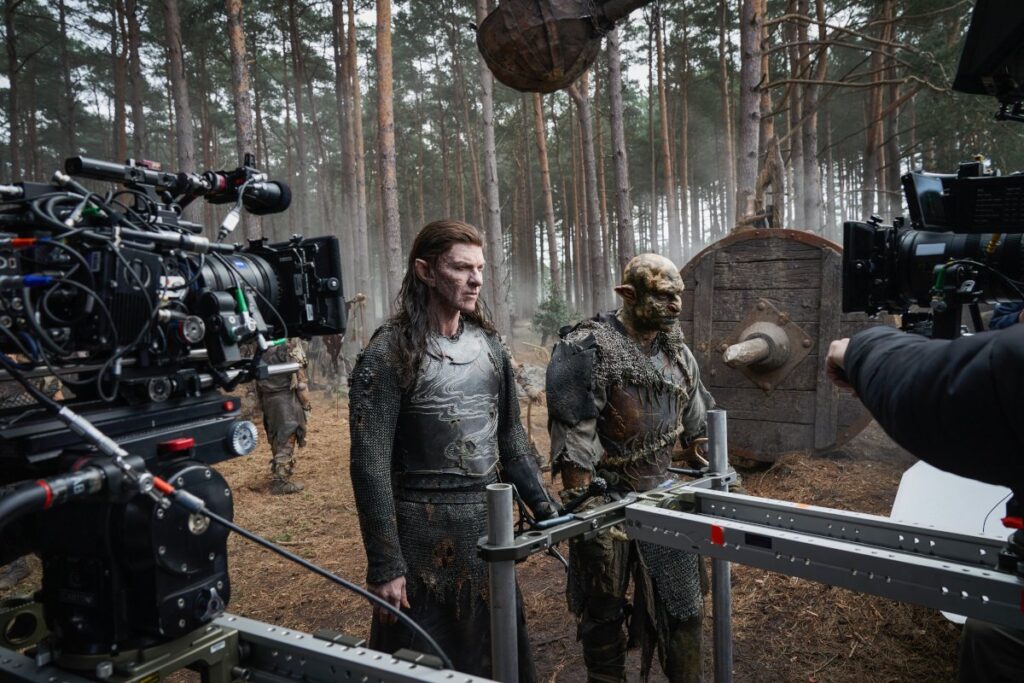Making a high fantasy series means designing and constructing otherworldly sets, carefully shaping a set to become, for example, the throne room of Númenor. It also means outfitting hundreds of orcs with prosthetics and maintaining an ear library. Many of those orcs were resting around the edges of a battle scene when Nerdist and a small group of reporters visited the set of The Lord of the Rings: The Rings of Power in 2023. The series was filming at Buttersteep Rise in Windsor Great Park, and we planted our wellies-covered feet carefully through thick mud and around performers pulling their orc prosthetics out of the way to drink smoothies through straws.
Even orcs like a smoothie.
In our day on set, we spoke with The Rings of Power showrunners, some of the cast, production design, the prosthetics department, props, and more. Here are seven details we learned about The Rings of Power season two.
1. Filming in the UK
Season one of The Rings of Power filmed in New Zealand, but the series moved to the United Kingdom for season two. Executive producer Lindsey Weber noted the decision came from Amazon, because they wanted to centralize their hub in the UK. But, she noted, it’s one of the best places to shoot. She said, “There’s a wonderful crew, actor, and filmmaking base. It does feel like there are new pools of talent here that we hadn’t used in season one. And certainly, we’re in all these locations that Tolkien wrote about.”
Supervising art director Martin Foley joked that when they first showed the showrunners Windsor Great Park and its 900-year-old trees, JD Payne and Patrick McKay literally hugged the trees.
2. Speaking of New Zealand…
The show did have a lot built for season one in New Zealand, and the production team had a lot of things shipped over—as in 70 containers full of items for not only the art department. Production designer Kristian Milsted said, it wasn’t so much full sets as smaller pieces like doors, windows, and detailed panels. Foley said, “Things took a long time to make and were expensive, and they were packed up carefully. We got these lovely notes. You’d open the containers, and they’d be like, ‘Please look after this. It took me months.’ It was quite sweet considering how abruptly that ended. You weren’t sure what you’re going to get, and then in terms of their messages, but they’re all really positive and really nice.”
3. The Voice of Sauron

Leith McPherson is The Ring of Power‘s supervising dialect coach; she worked on dialect for The Hobbit trilogy, too. She had the challenge of working with Charlie Vickers to turn his Halbrand accent into something different for season two.
McPherson said, “When I work for the actors, I work in the accent that the actors are working in. So Halbrand, it’s that northern kind of quality. He [Charlie Vickers] and I spoke like that for 18 months together and then it was, ‘Okay. So now you’re a different character kind of. Are you? I don’t know.’ Then we were speaking to each other in a new accent. Because this is an evolving, changing character where you are always thinking about the communication that that character is trying to have with others—what impression is he trying to make and what is he trying to achieve? So we talk about that vocally. How that manifests is an interesting thing.”
4. The Rings in The Rings of Power
Season two brings more rings to Middle-earth. Celebrimbor forged the three Elven rings at the end of season one, and set decorator Tina Jones and her team remade those Elven rings for season two. To come up with the designs for the new rings, the team went to different museums, including the British Museum to gather research and take photos. They also referenced design concepts from John Howe, a Tolkien artist. The camera would pick up any small imperfection in a manmade stone, so they used real stones for macro shots.
5. Orcs Everywhere
Season two has 1,500 actors in orc makeup. The prosthetics are a four-part application process including a cowl, a forehead, a chin, and a face. These can be mixed and matched to create unique looks. It takes two people two and a half hours to apply each set of prosthetics, and no, I am not doing that math. When we stopped by the prosthetics department to talk with Sarah Gower, she and her team were working on outfitting the second wave of orcs for the day.
6. Action and Stunts

If I could pick a theme for season two just from visiting the set, it’s more. More locations, more orcs, and more action. More everything. Supervising stunt coordinator Ben Cooke told us Galadriel and Elrond both see a lot more action, specifically on horseback. Cooke and his team worked for eight months on season two stunts that include wirework, high falls, and fires. Rehearsals started three to four months before filming. Part of Cooke’s work includes choreographing different action to match the styles of the Elves, orcs, Dwarves, etc.
7. Dwarven Beards
Hair and makeup designer Flora Moody walked us through a number of wigs. As she so aptly put it, “There’s a lot of hair.” Indeed when you think about the number of flowing locks in The Rings of Power, you realize how much effort it must take to maintain so many wigs. There are hero wigs, scale wigs, stunt double wigs, and sometimes picture double wigs. It adds up to, as Moody says, “an organizational feat.”
The wigs are all made from human hair when possible, but Dwarven beards, those are yak hair. The department uses two different types of yak hair. Tail of yak makes for a coarser hair. For a softer beard, it’s yak belly hair.
The makeup and hair department can make subtle changes that speak to character growth. For example, they gave Trystan Gravelle’s Pharazôn a 300-style beard to speak to his character becoming a bit more powerful.
The Lord of the Rings: The Rings of Power season two premieres on Prime Video on August 29.

